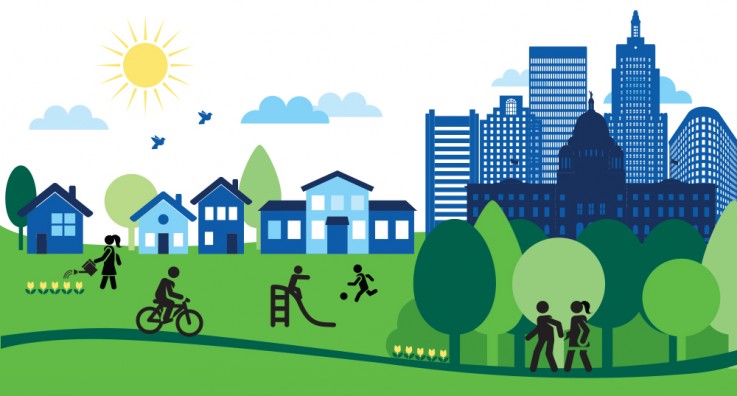What’s this all about and how does it link to health?
The built environment is the human-made, physical setting in place for human activities – it can include considerations such as where people live, work, learn and play. Whether rural or urban, healthy built environments are places that can be intentionally designed to support good health. A healthy neighborhood design includes:
- employment, amenities and services located near or among residential areas;
- connected street patterns which encourage active forms of transportation such as walking and, cycling; and
- housing choices, suiting people of all incomes, ages, and abilities.
Corresponding key design elements include three important ‘C’s:
- complete: a variety and mix of land uses are available in the community
- compact: the community is concentrated, not spread thinly over a large area
- connected: the layout makes it convenient and pleasant to get to destinations
Living in neighborhoods that offer opportunities to be active and provide access services is a boost to health. Unfortunately, people with low incomes generally have poorer health status, more barriers to making healthy choices, and less of a voice to advocate for changes that result in better health.
Physical Activity
If routine neighborhood destinations (shopping, work, etc.) are near to home, and if it is safe and easy to get there by active transportation, residents are more active in daily life. People living higher density neighborhoods, offering a mix of services within walking distance, are 2-4 times more likely to meet their 30 minutes of recommended daily activity requirements. Parks, trails, and playgrounds are a key part of a healthy design because they encourage active transportation and exercise. In places with direct pathways connecting homes with destinations (stores and parks), people are more likely to engage in moderate physical activity for 30 minutes or more per day.
Healthy Eating
The location of grocery stores and other sources of healthy food in close proximity to home can positively affect our ability to make healthy choices. Easy access to unhealthy food sources can negatively impact health as over-consumption of "junk foods" raises the risk for diabetes, heart disease, and certain cancers.
Social Connections, Safety and Access to Services – the glue that holds the people in communities together
Communities where people are active and socialize are associated with greater prosperity, lower crime, greater overall community cohesion, and better engagement with local government. Connected communities are also safer. Safety is linked with a higher residential density and mixed land use since such places can be vibrant with social activity in daytime and in the evenings. Children, elderly adults, people with disabilities, and people with lower incomes particularly benefit from healthy community design and land use because it provides them with convenient access to community services and connections close to where they live without driving.
Evidence shows that people have better health when they live in communities that are designed to support day-to-day healthy choices, such as being physically active, eating healthy food, and engaging in positive social interactions. Regardless of where you live and your reality, these are important considerations to keep in mind as we journey together for a healthier tomorrow.


